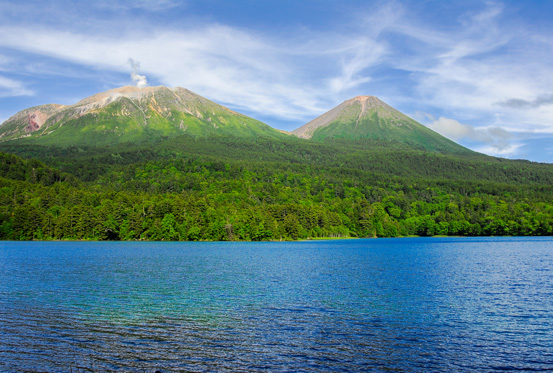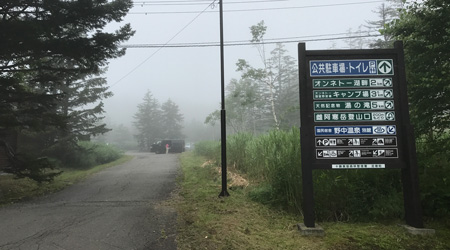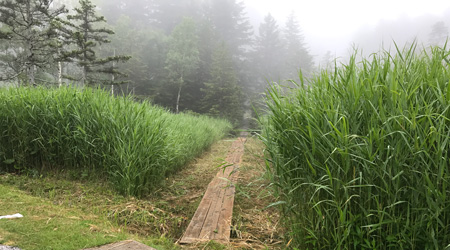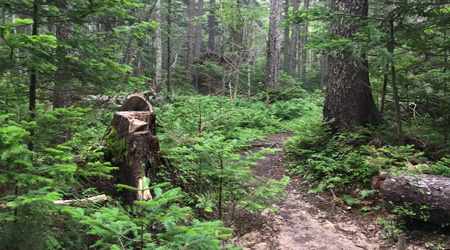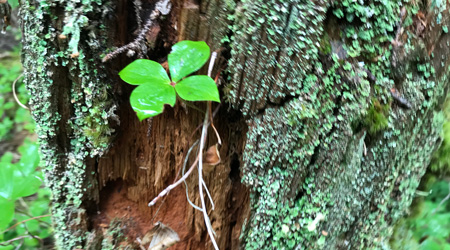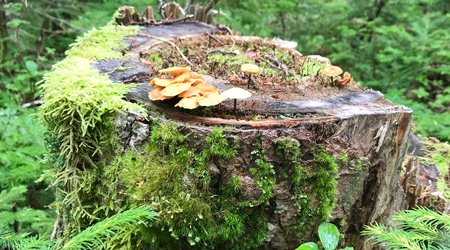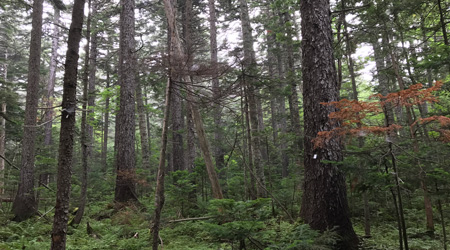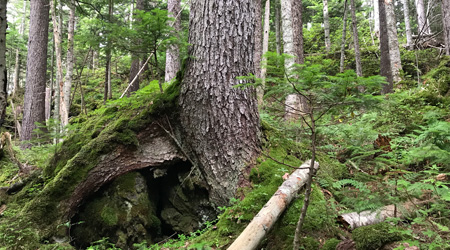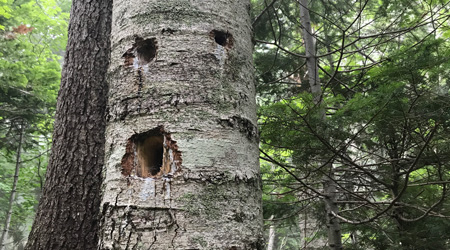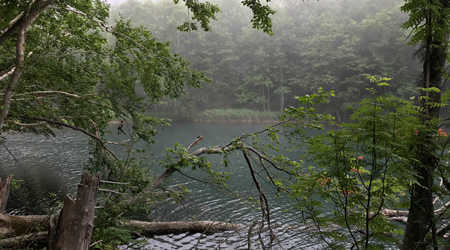Meakan Onsen parking, a 20 minute drive from the Akan lakeside, is the starting point of this course. Behind the parking area is a boardwalk, where you first pass a reed-filled marsh. The wetlands, where the plants accumulate without decomposition, are the characteristic environment of Hokkaido that belongs to the subarctic zone. The wetlands are oligotrophic and therefore lacking in nutrients a perfect environment to find the sundew, an insectivorous plant, which has adapted to such an environment. There are small, sticky, red hairs around the edge of its small, round leaves.
You can see firsthand the moment of life-and- death when a small bug, which has become entrapped and can’t move, is digested from the liquid which comes out from the hair. As we gothrough the wetlands, we enter a thick, mossy, forest. Although this coniferous forest is mostlydark, light filters in through the overhead canopy.
The contrast is just beautiful, and makes one’sheart calm. Japanese people feel an almost religious experience by such a sight. For the Japanese, there is beauty in the contrast between shadow and light, rather than just the way the light illuminates everything. After walking for 5 minutes, pure forests of red Ezo spruce between 150 and 200 years old spread out before me.
The trees are not as thick as I expected. I wonder how the red Ezo spruce trees have been able to stand in this severe volcanic area. Coming upon roots of fallen trees along the way, I notice that the roots are very shallow, which must be one of the ways the trees can grow in such a severe environment.
On the mossy fallen trees, a mass of young trees are coming out. Fallen trees foster renewal. A tree collapses, and on that fallen tree, the next generation of trees are growing. This sight is a perfect snapshot of one part of the circle of life — digenesis in front of our eyes! When I touch a mossy fallen tree, I feel warm although it is cold and wet. “Is this tree alive or dead?”
The parent tree has died, but devoted its own body to her offspring. On the other hand, I feel, with this warmth, young trees and mosses are protecting the fallen trees against rain and winds. There’s no border between life and death. This whole thing feels as one life.
On the fallen trees and root-stumps, we see not only the renewal of young red Ezo spruce but also other young trees such as Sakhalin fir. It is a succession of nature where the entire forest is passing on to its next generation.
Here in Akan, big eruptions have taken place every thousand years, renewing its ground. The oldest ground, Mt. Fuppushidake, is made up of forests of Sakhalin fir, Fuppu in the Ainu language, which reach up to its summit. On the second oldest, Mt. Oakandake, we can see the trees are coming close to the summit. On the newest, Mt.Meakandake, rock surfaces lay bare, and red Ezo spruce, which can grow in acidic soil, make a pure forest. In a thousand year period, forests have been created, and by volcanic eruption the process begins again.
Within such an environment, Hokkaido people’s perception of time has nurtured a time axis in which they think of things in units of one-thousand years. After walking and sometimes straddling over and going under fallen trees for 15 minutes, we reach a small, square-shaped patch in the forest. The black forest reminds me of the northern forests in Siberia and Northern Europe, but the small hills are mossy, with large natural rocks arranged haphazardly by volcanic eruptions. The growing trees and plants there seem to me a prototype of a Japanese garden. Such blending between Japanese and western styles is also one of the features of the natural scenery and living in Hokkaido.
After walking 10 minutes into the pure forest of red Ezo spruce, a swamp appears on our left, and we continue walking down along the swamp. We can see the spreading roots of the trees as if they were wrapping big rocks with their hands. The rocks must have spewed out at the time of the formation of Mt. Meakandake. Walking down another 15 minutes, Lake Onneto appears with its blue, lake surface from gaps between the trees. The acidic spring water, which is a hot spring, flows in from the lake bottom. The qualities of this water produce mysterious forms of ever-changing colors on the lake’s surface and also preserve the fallen and sunken trees forever. When we reach the lake, we turn left toward Onneto Campsite. From the campsite, you can go back along the path you have come, or you may return on the paved road on the opposite shore.
Finally we finish our little trek by bathing in the hot spring. From a bathtub made of red Ezo spruce, you will be reminded of the forest you have just visited. “Trees are living twice.” We are living with the trees. Trees are cut into lumber, then changed into houses and furniture to live with us forever.
